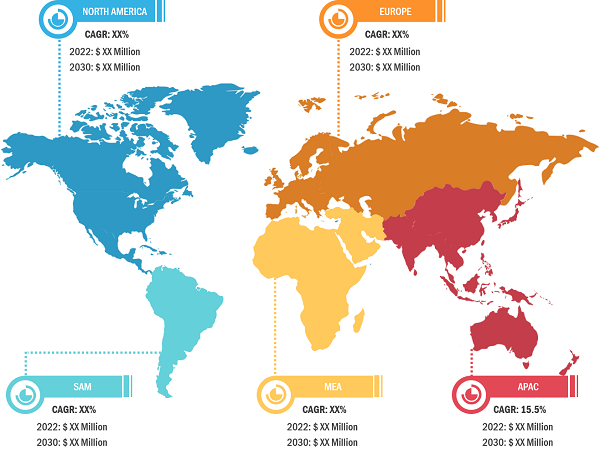Rising Use of Biometric Technologies in Consumer Electronics Boosts Biometric Technologies Market Growth
According to our latest study titled “Biometric Technologies Market Forecast to 2030 – Global and Regional Share, Trends, and Growth Opportunity Analysis – by Component, Type, Authentication Type, and End User,” the market size is projected to grow from US$ 37.85 billion in 2022 to US$ 118.35 billion by 2030 at a CAGR of 15.3%.
The consumer electronics industry registers immense growth in developed and developing countries, primarily due to advancements and smart features offered by these devices. Currently, consumer devices are used for a plethora of tasks, ranging from banking to online shopping. Tablets and smartphones, among other mobile devices, have become an integral part of consumers’ lives. All these devices are becoming smarter with ongoing advancements in artificial intelligence (AI) and the Internet of Things (IoT), and the integration of these technologies. In addition to all these factors, manufacturers frequently come up with advanced technologies and features in biometric authentication, including fingerprint, face, iris, and voice recognition, leading to the biometric technologies market growth.
Biometric Technologies Market – by Region, 2022 and 2030
Biometric Technologies Market Size and Forecast (2020 - 2030), Global and Regional Share, Trend, and Growth Opportunity Analysis Report Coverage: By Component (Hardware, Software, and Services), Type (Contact, Contactless, and Hybrid), Authentication Type (Single Factor Authentication and Multi-factor Authentication), End User (Government, BFSI, Healthcare, Defense and Security, and Others), and Geography
Biometric Technologies Market Key Findings and Share by 2030
Download Free Sample
Source: The Insight Partners Analysis
The integration of biometric authentication in smartphones and other devices by large companies such as Google, Apple, Huawei, and Samsung would further drive the demand for biometric sensors. For instance, in August 2022, researchers developed a biometric tool called EarEcho to unlock smartphones using earbuds. Besides reducing the need for passcodes, fingerprints, facial recognition, and other biometrics, the tool would be ideal for situations where users need to verify their identity, e.g., while making mobile payments. In April 2023, the Unique Identification Authority of the Indian Institute of Technology, Bombay (IIT-Bombay) announced their ongoing project to develop a robust touchless biometric capture system facilitating easy, anytime, anywhere usage. With the increasing popularity and use of digital services such as digital payments, mobile wallets, and mobile banking, the demand for advanced user authentication on consumer devices is growing at a fast pace to ensure security and convenience for customers. The introduction of biometric capabilities in consumer devices has revolutionized user identification and credentialing in sectors such as banking and finance by reducing risks of payment fraud, identity theft, and other possible frauds. Thus, an upsurge in the adoption of biometric-enabled consumer devices such as smartphones, tablets, and speakers bolsters the biometric technologies market size. Further, the increasing use of biometric systems at airports is expected to bring new biometric technologies market trends in the coming years.
The Biometric Technologies market analysis has been carried out by considering the following segments: component, type, authentication type, and end user. Based on component, the market is segmented into hardware, software, and services. Based on type, the market is segmented into contact, contactless, and hybrid. Based on authentication type, the biometric technologies market is segmented into single-factor authentication and multifactor authentication. Based on end user, the market is segmented into government, BFSI, healthcare, defense and security, and others. The government segment held the largest biometric technologies market share in 2022.
The scope of the Biometric Technologies market report is primarily divided into North America (US, Canada, and Mexico), Europe (Spain, UK, Germany, France, Italy, and Rest of Europe), Asia Pacific (South Korea, China, India, Japan, Australia, and Rest of Asia Pacific), Middle East & Africa (South Africa, Saudi Arabia, UAE, and Rest of Middle East & Africa), and South & Central America (Brazil, Argentina, and Rest of South & Central America). North America accounted for the largest biometric technologies market share in 2022. The market in this region is segmented into the US, Canada, and Mexico. North America accounts for a significant share of the biometric technologies market. Surging data theft identity fraud incidences, and terrorist operations, among other security breaches, are driving the biometric technologies market in North America. In October 2023, the House Foreign Affairs Committee and the U.S. Senate Committee on Homeland Security & Governmental Affairs faced a cyberattack from Vietnamese hackers trying to install spyware on the phones of journalists. This propels the demand and adoption of biometrics technologies to handle unlawful practices and enhance national security. Biometric authentication in phones unlocks greater security due to its resistance to most common cyberattacks such as password cracking or phishing. Biometric technologies offer an efficient way to keep physical attacks and cyber-attacks in check by delivering more stringent security measures to users.
Aware Inc, Thales SA, Cognitec Systems GmbH, NEC Corp, IDEMIA France SAS, HID Global Corp, Fujitsu Ltd, Leidos Holdings Inc, M2SYS Technology, and Precise Biometrics AB are among the key players profiled in the biometric technologies market report.
Contact Us
Phone: +1-646-491-9876
Email Id: sales@theinsightpartners.com